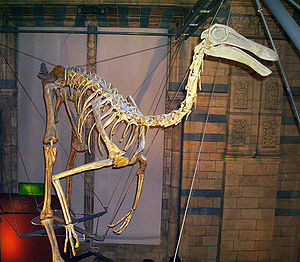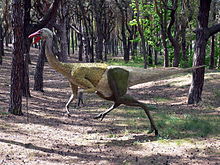Gallimimus
| Gallimimus | ||||||||||||
|---|---|---|---|---|---|---|---|---|---|---|---|---|

Skeletal reconstruction of Gallimimus |
||||||||||||
| Temporal occurrence | ||||||||||||
| Upper Cretaceous (late Campanium to early Maastrichtian ) | ||||||||||||
| 76.4 to 69.9 million years | ||||||||||||
| Locations | ||||||||||||
| Systematics | ||||||||||||
|
||||||||||||
| Scientific name | ||||||||||||
| Gallimimus | ||||||||||||
| Osmólska , Roniewicz & Barsbold , 1972 |
Gallimimus was a genus of dinosaurs from the group of Ornithomimosauria within the Theropoda . He lived in the late Upper Cretaceous in what is now East Asia.
features
With a length of 4 to 6 meters, Gallimimus was one of the largest representatives of the Ornithomimosauria, although its physique largely corresponds to the other genera. He only moved biped (only on his hind legs). These were long and thin, especially the lower legs were elongated, which suggests that this dinosaur could run fast. The metatarsals were also elongated, the foot ended in three toes pointing forward. As with all ornithomimosaurs, the arms were relatively long, but delicately built. Gallimimus differed from the other dinosaurs in this group by the smaller hands.
The relatively small head sat on a long neck. The snout was elongated and U-shaped at the tip, presumably there was a horned beak there. Like all Ornithomimidae it was toothless. The big eyes sat on the side of the head.
In 2001, Gallimimus discovered a lamellar structure at the tip of both jawbones. This structure could indicate a filtering food intake, that is, it would have worked like a sieve to fish small organisms out of the water. A similar form of food intake is also found in today's birds, such as the shoveler or the flamingos . It is also conceivable that this dinosaur was omnivorous and also ingested plant material.
Discovery and naming
The fossil remains of Gallimimus were discovered in the Nemegt Formation in the Mongolian province of Ömnö-Gobi-Aimag and first described in 1972 . The name means "chicken imitator" and is in the tradition of naming ornithomimosauria as imitators ( mimus ) of various birds. The type and only known species is Gallimimus bullatus . The finds are dated to the late Upper Cretaceous (late Campanian to early Maastrichtian ) to an age of approx. 76 to 69 million years.
literature
- Peter J. Makovicky , Yoshitsugu Kobayashi, Philip J. Currie : Ornithomimosauria. In: David B. Weishampel , Peter Dodson , Halszka Osmólska (eds.): The Dinosauria . 2nd edition. University of California Press, Berkeley CA et al. 2004, ISBN 0-520-24209-2 , pp. 137-150.
Web links
Individual evidence
- ^ Gregory S. Paul : The Princeton Field Guide To Dinosaurs. Princeton University Press, Princeton NJ et al. 2010, ISBN 978-0-691-13720-9 , p. 114, online .
